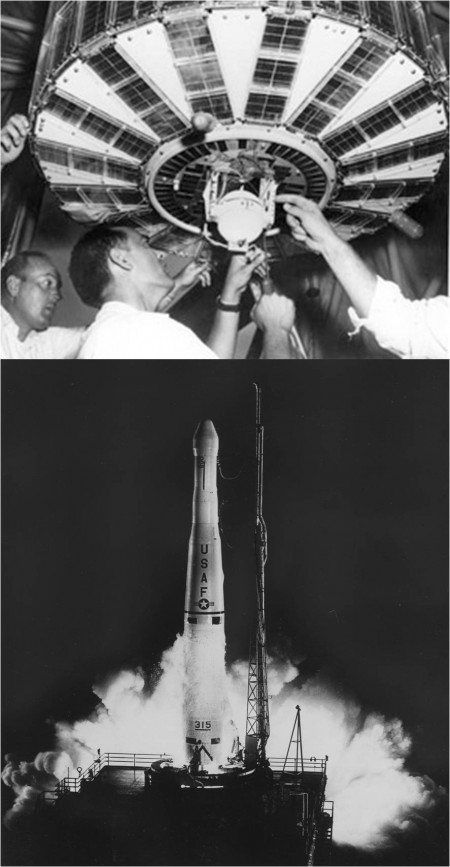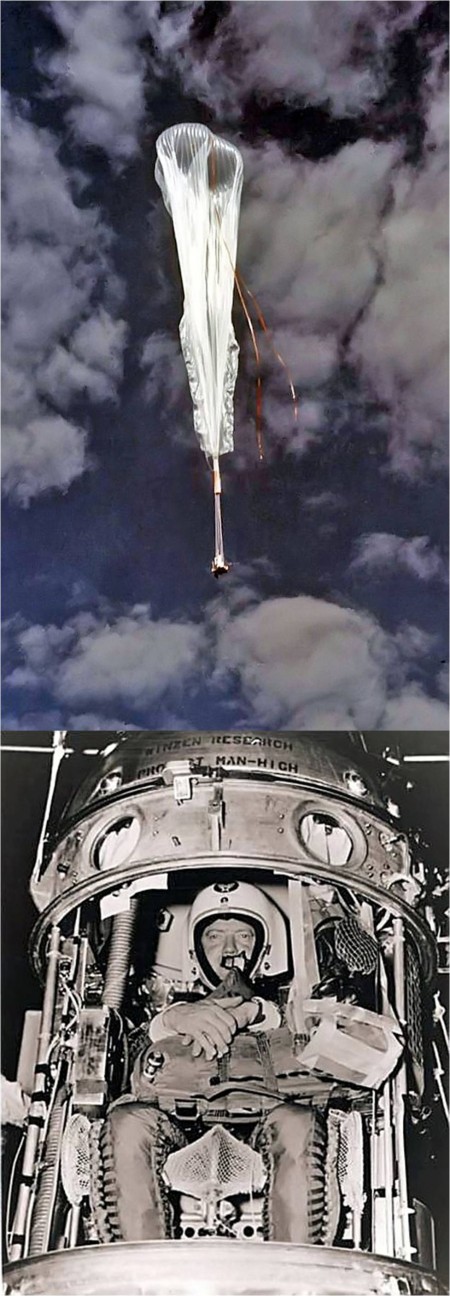
Fifty-two years ago this week, the United States Navy successfully orbited the Transit 4A navigation satellite which carried the SNAP-3A Radioisotope Thermoelectric Generator (RTG). This historic mission marked the first time that an RTG was used as a spacecraft power source.
Transit was the first operational satellite navigation system. More formally known as the Navy NAVSAT (Navigation Satellite) System, Transit provided accurate global position data in support of naval worldwide sea operations. The navigation of submarines and surface ships was greatly aided by Transit-provided data as were sundry hydrographic and geodetic surveying programs.
Transit was developed for the Navy by the Applied Physics Laboratory of the Johns Hopkins University (JHU/APL). Work began in 1958 and launch of the first prototype Transit satellite, Transit 1A, took place in September 1959. A number of Transit satellite launches took place over the next 5 years with the system going operational in 1964.
Transit satellites provided position data that was accurate to within about 3 feet. The system revolutionized global navigation and was ultimately used by an untold number of ships and boats. Transit navigational operations ceased in 1996 with the advent of the Global Positioning System (GPS). One of the great benefits of GPS is that position data are provided continuously whereas Transit provided discrete data about once an hour.
Transit 4A was unique in that an experimental Radioisotope Thermoelectric Generator (RTG) was carried onboard the spacecraft. An RTG coverts the heat generated by the natural decay of a radioisotope fuel into electricity. This device is especially useful for power generation applications where solar arrays are either impractical or inadequate. An example application would be a long duration mission in deep space.
The 3-watt RTG carried onboard Transit 4A was officially known as the Systems For Nuclear Auxiliary Power (SNAP-3). Being experimental in nature, it only provided power to instrumentation and a pair of Transit 4A’s quartet of radio transmitters. Later versions would provide power for all spacecraft systems.
The Transit 4A satellite was cylindrical in shape, measuring 43 inches in diameter and 31 inches in height. The spacecraft weighed 174 lbs. The majority of its external surface was covered with solar cells that charged nickel-cadmium batteries.
On Thursday, 29 June 1961, Transit 4A was launched from Cape Canaveral’s LC-17B at 04:22 UTC. The Thor Ablestar 315 launch vehicle successfully placed Transit 4A into a 596-nm x 515-nm earth orbit. Two other satellites (GRAB and Injun) were also orbited on this mission. They separated from Transit 4A, but not from each other. GRAB 3 had a SIGINT mission. Injun was a USN satellite investigating radiation in Earth’s magnetosphere.
Transit 4A became the longest continuous broadcasting spacecraft in 1966. It continued to hold that distinction through 1971; the type’s 10th anniversary in space. At that point, the satellite had traveled more than 1.7 billion miles in space and flown around the Earth more than 55,000 times.
By the end of 1996, the Transit satellites were no longer utilized for navigation purposes and were superseded by the Navstar Global Positioning System (GPS). However, Transit satellite systems were still operating well and the spacecraft continued to transmit valuable data from orbit. The Navy renamed the Transit Satellite System as the Navy Ionospheric Monitoring Systems (NIMS).
The RTG technology pioneered on the Transit 4A mission matured significantly over the next five decades. During that time, RTG’s provided a safe, reliable, and maintenance-free means for generating spacecraft thermal and electrical power. Indeed, RTG’s have proven pivotal to the success of numerous manned and unmanned space missions including those associated with the Apollo, Viking, Pioneer, Voyager, Galileo, Ulysses, and Cassini Programs.

Forty-seven years ago this week, USAF’s Space and Missile Systems Organization (SAMSO) successfully orbited an octet of satellites on the first mission of the Initial Defense Communication Satellite Program (IDCSP). This feat marked the beginning of America’s first operational geosynchronous orbital communications system.
The Initial Defense Communications Satellite Program (IDCSP) was the world’s first military satellite communications system. It consisted of clusters of small, polygonal satellites deployed in near-geosynchronous earth orbit. IDCSP satellites transmitted both voice and photographic data vital to U.S. military commanders.
Each IDCSP satellite external configuration was a 26 sided polygon measuring 34-inches in diameter. With a mass of roughly 100 lbs, the communication satellite was spin-stabilized and its external surface was almost completely covered with solar cells. With the onus on simplicity, the type employed neither internal storage batteries nor an active attitude control system.
During a typical IDCSP mission, up to eight (8) satellites were placed into near-geosynchronous earth orbit by a single launch vehicle. Each satellite was dispensed individually. Since their orbits were not quite synchronous, IDCSP satellites drifted west to east up to 30 degrees per day. This feature helped ensure that at least one satellite was always visible to a ground station in the event that an adjacent IDCSP satellite became non-op.
On Thursday, 16 June 16 1966, an USAF Titan IIIC launch vehicle lifted-off from Cape Canaveral’s LC-41 at 1400 UTC. The multi-staged booster successfully placed seven (7) IDCSP satellites and a single gravity-gradient experimental satellite into equatorial orbit at an altitude of approximately 18,354 nm. Each of the constituent satellites functioned well and successfully passed a series of on-orbit preliminary tests. The IDCSP system then declared “operational” in short order.
Between June of 1966 and June of 1968, a total of twenty-six (26) IDCSP satellites were orbited by USAF Titan IIIC launch vehicles. A quartet of launches was required to accomplish such. While the IDCSP system was experimental in nature, it in fact provided the United States with a viable space-based, global communication network for over a decade.
IDCSP satellites transmitted reconn photographs and other intelligence data throughout the Vietnam War. At the point of IDCSP initial operating capability (IOC), the system was redesignated as the Defense Satellite Communications System I (DSCS I). Enhanced-capability variants, DSCS II and DSCS III, came in succeeding years (the later serving into the 21st century).

Forty-eight years ago this month, Astronaut Edward H. White II became the first American to perform what in NASA parlance is referred to as an Extra Vehicular Activity (EVA). In everyday terms; a space walk.
White, Mission Commander James A. McDivitt and their Gemini IV spacecraft were launched into low Earth orbit by a two-stage Titan II launch vehicle from LC-19 at Cape Canaveral Air Force Station, Florida. The mission clock started at 15:15:59 UTC on Thursday, 03 June 1965.
On the third orbit, less than five hours after launch, White opened the Gemini IV starboard hatch. He stood in his seat and mounted a camera to capture his historic space stroll. He then cast-off from Gemini IV and became a human satellite.
White was tethered to Gemini IV via a 15-foot umbilical that provided oxygen and communications to his EVA suit. A gold-plated visor on his helmet protected his eyes from the searing glare of the sun. The space-walking astronaut was also outfitted with a hand-held maneuvering unit that used compressed oxygen to power its small thrusters. And, like any good tourist, he also took along a camera.
Ed White had the time of his all-too-brief life in the 22 minutes that he walked in space. The sight of the earth, the spacecraft, the sun, the vastness of space, the freedom of movement all combined to make him exclaim at one point, “I feel like a million dollars!”.
Presently, it was time to get back into the spacecraft. But, couldn’t he just stay outside a little longer? NASA Mission Control and Commander McDivitt were firm. It was time to get back in; now! He grudgingly complied with the request/order, plaintively saying: “It’s the saddest moment of my life!”
As Ed White got back into his seat, he and McDivitt struggled to lock the starboard hatch. Both men were exhausted, but ebullient as they mused about the successful completion of America’s first space walk.
Gemini IV would eventually orbit the Earth 62 times before splashing-down in the Atlantic Ocean at 17:12:11 GMT on Sunday, 07 June 1965. The 4-day mission was another milestone in America’s quest for the moon.
The mission was over and yet Ed White was still a little tired. But then, that was really quite easy to understand. In the time that he was working outside the spacecraft, Gemini IV had traveled almost a third of the way around the Earth.
Now, that’s a long walk!

Fifty-six years ago this month, USAF Captain Joseph W. Kittinger successfully completed the first Manhigh aero medical research balloon mission. During his 6.5-hour flight, Kittinger reached an altitude of 95,200 feet above mean sea level.
Project Manhigh was a United States Air Force biomedical research program that investigated the human factors of spaceflight by taking men into a near-space environment. Preparations for the trio of Manhigh flights began in 1955. The experience and data gleaned from Manhigh were instrumental to the success of the nation’s early manned spaceflight effort.
The Manhigh target altitude was approximately 100,000 feet above sea level. A helium-filled polyethylene balloon, just 0.0015-inches thick and inflatable to a maximum volume of over 3-million cubic feet, carried the Manhigh gondola into the stratosphere. At float altitude, this balloon expanded to a diameter of about 200 feet.
The Manhigh gondola was a hemispherically-capped cylinder that measured 3-feet in diameter and 8-feet in length. It was attached to the transporting balloon via a 40-foot diameter recovery parachute. Although compact, the gondola was amply provisioned with the necessities of flight including life support, power and communication systems. It also included expendable ballast for use in controlling the altitude of the Manhigh balloon.
The Manhigh test pilot wore a T-1 partial pressure suit during the Manhigh mission. This would protect him in the event that the gondola cabin lost pressure at extreme altitude. The pilot was hooked-up to a variety of sensors which transmitted his biomedical information to the ground throughout the flight. This allowed medicos on the ground to keep a constant tab on the pilot’s physical status.
The flight of Manhigh I took place on Sunday, 02 June 1957 with USAF Captain Joseph W. Kittinger as pilot. The massive balloon carrying Kittinger and his gondola was released at 11:23 UTC from Fleming Field Airport, South Saint Paul, Minnesota. In less than 2 hours, Kittinger’s balloon reached its design float altitude of 95,200 feet.
Radio communication problems complicated the Manhigh I mission. While Kittinger could hear the ground, the ground could not hear him. However, the resourceful pilot managed to work around this issue by communicating with the ground via Morse code.
Though balloon, gondola and pilot were functioning quite well, the Manhigh I mission had to be cut short due to rapid depletion of the gondala’s oxygen supply. Post-flight investigation revealed that this anomaly was caused by accidental crossing of the oxygen supply and vent lines prior to the flight.
Kittinger made a safe and uneventful landing near Indian Creek, Minnesota; located roughly 60 nm southeast of the launch site. The recovery crew was quick to the scene and extracted the plucky pilot from the sealed balloon gondola which had fallen over on its side. The official mission elapsed time was 6 hours and 32 minutes.
The flight of Manhigh I was a significant technical accomplishment that materially contributed to the advancement of manned spaceflight. Indeed, a TIME Magazine article, entitled “Prelude to Space” and dated 17 June 1957, captured the essence of the achievement. A man had been subjected to space-equivalent physiological conditions for a protracted period, had functioned well in that environment, and then returned safely to earth without ill effect.
For his significant efforts during the Manhigh I mission, Captain Joseph W. Kittinger received the USAF Distinguished Flying Cross.





